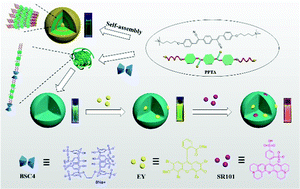The construction of an artificial light-harvesting system with two-step sequential energy transfer based on supramolecular polymers†
Abstract
An artificial light-harvesting system with two-step sequential energy transfer was constructed in aqueous media based on cyano-substituted p-phenylenevinylene derivative (PPTA) and bis-(p-sulfonatocalix[4]arenes) (BSC4) supramolecular polymers formed through host–guest interactions, in which two different fluorescent dyes, eosin Y (EY) and sulforhodamine (SR101), were employed as energy acceptors. The obtained artificial light-harvesting system can achieve an efficient two-step energy transfer process from PPTA–BSC4 to EY and then to SR101 with high energy-transfer efficiencies of up to 36.6% and 40.8%, respectively. More importantly, the harvested energy from the PPTA–BSC4 + EY + SR101 system can be used to promote the dehalogenation of α-bromoacetophenone with a yield of 89% in aqueous solution.



 Please wait while we load your content...
Please wait while we load your content...